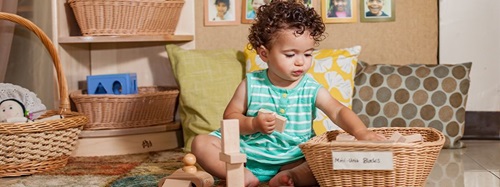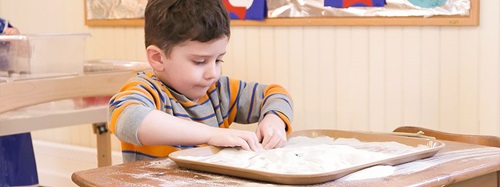Separation and Reunion
Helping Children and Parents Cope with Arrivals and Departures
| May 2011GOOD-BYES ARE OFTEN PAINFUL
Staff needs to acknowledge that the pain of separating is real for parents and children. This is so even for a child who has been coming to child care for some time and is apparently settled in. Even when a child knows the teacher and the program, enjoys his time at the program, and at some level knows that his parent will return at the end of the day, the act of parting can still be painful. It may be tempting for staff and parents to deny the reality of such distress.
It is the teacher’s job to help parent and child separate. Greeting and welcoming parents and children makes it easier for children to make the transition from home to child care and reassures parents. For children, saying good-bye to loved ones is much easier within the arms of another special person.
HELP PARENTS SEPARATE AND GET OFF TO WORK
Encourage parents to plan a leisurely drop-off when possible. Saying good-bye is easier for a child if the parent does not race in and race out and the staff aren’t rushing on to other responsibilities. It works best when parents and staff can be flexible and can have relaxed conversations.
Help parents overcome their ambivalence and assist them in saying good-bye. When a child is distressed, parents may feel as if they should not leave until the child has become happy. Sometimes parents are reluctant to leave because they are uncertain about leaving their child in your care—or in any care, for that matter. They may say several times that they are going to leave but then don’t; they may actually leave and then reappear. Parents who have difficulty separating require sympathetic assistance from staff, not criticism. Some parents will need gentle but direct advice about leaving if they are clearly floundering and don’t seem to know when and how to depart. This does not mean that staff should make the decision for them. Instead, staff should offer to help parents leave at the point when they decide to leave. They may need reassurance that being consistent helps a child adjust. Parents will be reassured when staff call or send them e-mails at work that report how the child is doing. Photos of a happy child are the best reassurance.
Try to prevent parents from sneaking out. Parents may be tempted to sneak away without saying good-bye, thinking either that this will be best for their child or that by doing so they will avoid the pain they feel when leaving their distressed child. While showing sympathy for parents’ pain, staff should help them understand that it is never best to leave without saying good-bye, because doing so diminishes a child’s feelings of trust and security and may in fact cause the child to become even more clingy.
Encourage parents to communicate with you during the day. Parents should be encouraged to phone or e-mail during the day to find out how their child is doing. Staff should see this as an important aspect of building trusting relationships. Reports to parents at these times should be positive and optimistic but honest. If the child is still upset, say so. Reassure the parent that this type of behavior is typical and that things will get better.
SUPPORT CHILDREN BY ACKNOWLEDGING THEIR FEELINGS
Staff should help children through hard times by acknowledging their feelings, comforting them, and framing their feelings in words. One of the many things children learn from adults in the early years is what feelings are appropriate in different situations and how to recognize and acknowledge their feelings. Children need to have their feelings validated, not ignored or denied. Simply distracting them to stop the distress is inappropriate unless it is preceded by communicated acceptance of their feelings. Acknowledge their feelings by saying something such as “I know you miss Mama. Are you very sad? Mama’s working, and you’ll see her after snack. Should we go look for a truck to play with?” instead of “You’re okay—let’s go play with the truck,” which ignores their unhappiness.
USE RITUALS AND SPECIAL OBJECTS TO HELP CHILDREN COPE WITH SEPARATION
A special ritual or routine for the child who is settling in can be comforting, such as helping the child engage in play, waving to the parent from the window, providing a kiss and a hug, or making a comment. “I love you, Sweet Pea, and I’ll be back” works for twenty-month-old Elena. Such a routine gives the child a feeling of control, a feeling of “I know what is going to happen now—when Dad leaves, my teacher Mary and I always go over and feed the fish, and then we find a good toy to play with.” Encourage the child to play an active rather than a passive role in the separation; this often helps. A structured departure ritual helps many parents and children.
Sixteen-month-old Samantha sits in her teacher’s arms, and together they open the door for Sam’s mom to leave, then wave good-bye and look out the window as she leaves. In the morning, when the father of two-year-old Ryan is about to leave for work, the two exchange photographs. Ryan gives his dad a picture of him at the center, and his father gives Ryan a picture of him at his desk. In the afternoon, they swap photos again, and leave them at the center until the next day.
It is natural for children to miss their parents during the day. Children new to the program may be comforted by having an object that belongs to the parent—for example, a scarf or handbag, accessible to them during the day. For some children, this seems to serve as an indication that Mom or Dad will definitely come back. This is a good exam¬ple of how the minds of young children often work differently from those of adults. We adults know that the parent will definitely come back to get the child, whereas for the child it makes sense that Mom will return to get her handbag! Having a photo of the family in a place accessible to the child can also be reassuring. Staff should talk about the parents with the child during the day in a natural way. Because it is such a positive way to build parent-child relationships, parents should be encouraged to visit during the day if circumstances permit, even if the child is sometimes distressed by a second separation. Parents who make time for their children should not be discouraged from doing so. If separation distress is prolonged, parents and staff should work together to resolve any concerns.
“SOON” TO WHOM?
It is tempting to comfort children by saying that Mom or Dad will be back soon. Soon is a word that has many interpretations, depending on the context in which it is used. Children have a good sense of sequence (what comes after what) but not of time. “Your birthday will come soon” may mean in two weeks; “Lunch will be here soon” may mean within thirty minutes; and when the teacher says, “We’ll have to go inside soon,” she may mean within five minutes. Consequently, saying to a child whose parent is due an hour from now that “Daddy will be here soon” can easily be misinterpreted and result in frustration and disappointment. For an older toddler, it may help to list all the events that will take place before the parent arrives. Saying, for example, “We will have a nap, then some afternoon tea, go outside, and when you have had a little play outside, your daddy will come” gives a more accurate sense of time to that child than soon. The safest thing is to avoid using the term.
REUNIONS: THEY DO LOVE PARENTS BEST!
While it is more likely that attention will be given to separations at the beginning of the day, reunions at the end of the day can be equally challenging. By the end of the day, staff, parents, and children are all likely to be tired. Children have usually had enough of being in a group, and as other children start going home, they begin to anticipate the arrival of their own parent. It may be difficult to be one of the last to leave. It is important to provide interesting things to do, as well as extra cuddles and attention, for those children who are not among the first to leave. Saving some special books or play materials for the end of the day can make the time special. In fact, the end of the day, if staffing is adequate and tasks are organized, can be a pleasant time, with fewer children and therefore more opportunity for prime times.
Selected material from Prime Times: A Handbook for Excellence
in Infant and Toddler Programs by Jim Greenman,
Anne Stonehouse, and Gigi Schweikert, © 2008.
Reprinted with permission of Redleaf Press,
St. Paul, MN; www.redleafpress.org.








